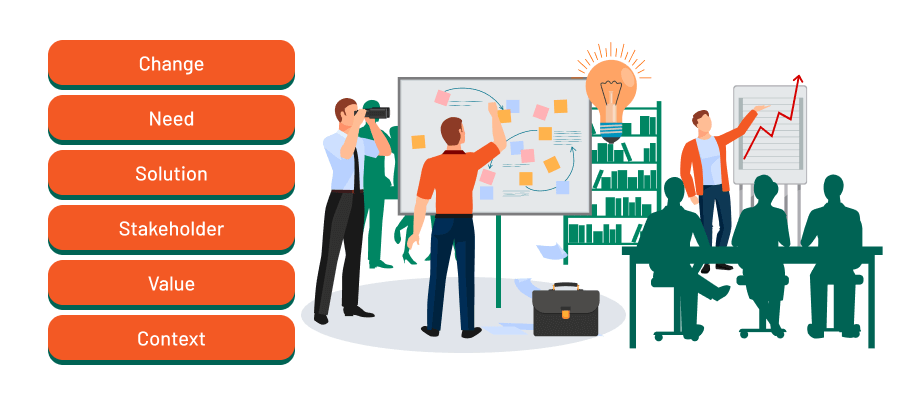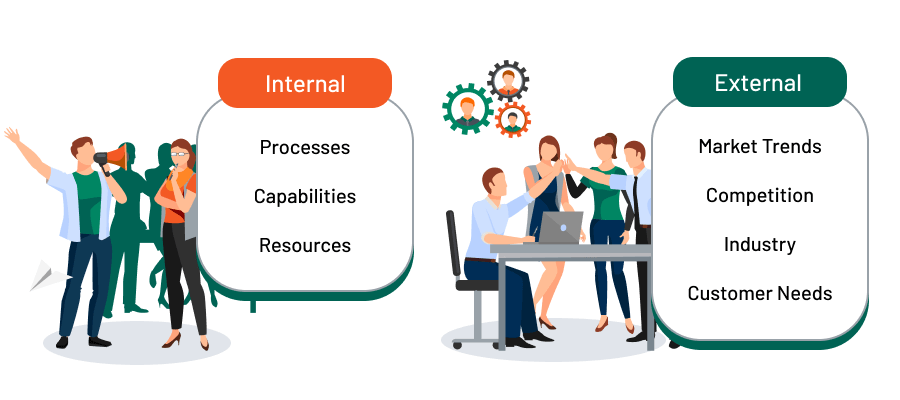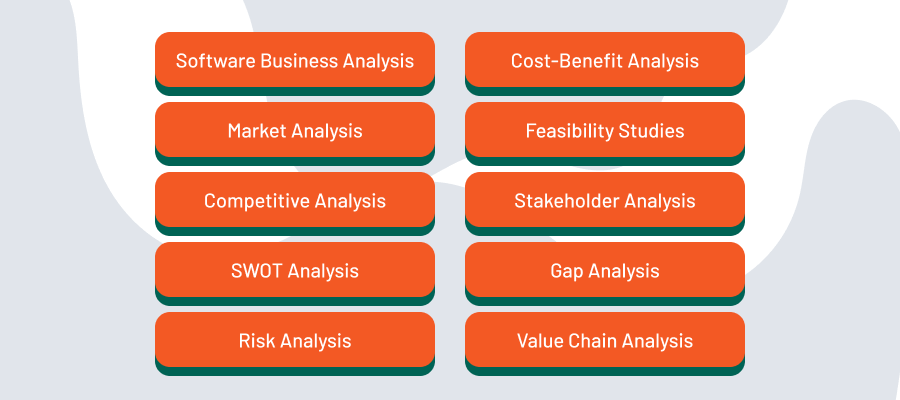In the whirlwind of software development, one critical yet often overlooked aspect is Strategic Business Analysis (SBA). Basically, SBA looks at what a company needs and then figures out smart solutions that connect what the business wants to achieve with the techie stuff.
When companies dive into making software without thinking about this business analysis thing, it’s like driving blindfolded. You might get somewhere, but it’s a gamble. With SBA, you have a roadmap. You know where you’re going, why you’re going there, and how to get there without crashing.
According to recent research, only 25% of companies deliver projects on time. Others exceed budgets and fail to meet stakeholder expectations. This underscores the urgency of adopting a strategic business analysis framework from the project’s inception. Stick around as we break down this not-so-glamorous but totally crucial side of software development.
So, what exactly is strategic business analysis?
Business Analysis in IT
Explore the best business analysis practices and techniques to bridge the gap between a project vision and IT execution.
What is Strategic Business Analysis?

Strategic business analysis is the thorough evaluation of various aspects — both internal and external — of a business to craft effective digital strategies. In software projects, it guides decision-making, shaping the success or failure of the product. It focuses on six core things:
- Change
- Need
- Solution
- Stakeholder
- Value
- Context
Generally, strategic business analytics is about understanding the market and competition and aligning technological capabilities with customer needs.
Analyzing businesses strategically has big advantages. It’s not just a fancy term. Whoever owns the product gets a clear understanding of market trends, what consumers want, and their competition. This knowledge helps them make good decisions and develop user-centered products that meet specific demands.
The Role of Strategic Business Analysis in Product Owners’ Success

Product owners often crunch numbers to figure out what customers really want, or they could chat with different teams to make sure everyone’s on the same page about where the product should go. Here, SBA helps product owners make smart choices. With the findings, they make sure the product not only meets customer needs but also stands out in the market.
Imagine how a social media platform is working on a new feature. The strategic business analyst digs into user data and market trends, finding out that users really want a feature for disappearing messages, which none of the competitors have.
They share this insight with the product development team. As a result, the team focuses on creating this unique feature. This decision gives the social media app an edge by providing a feature users are excited about.
This is just one example of how SBA benefits products, however, if we break down the levels of SBA, we’ll see how it serves a way wider spectrum of things.
Learn more How to Become a High-Performing Business Analyst
Strategic BA Levels

Strategic business analysis is applied at external and internal levels.
The external SBA focuses on understanding factors outside the company. They analyze the industry, market trends, competition, and customer needs. Their role involves managing relationships with stakeholders, assessing risks, conducting market research, evaluating technology, and creating strategic plans to help the company succeed in the market.
In contrast, the internal SBA deals with the company’s internal workings. They analyze internal processes, the company’s capabilities, and available resources to anticipate project challenges, such as avoiding delivery delays. Their primary goal is to ensure the company’s internal structure effectively supports its goals and strategies.
Below we’ll review some of the most popular strategic business analysis types that come in handy for any software project. Your first strategic BA task is to recognize what level they are meant for!
Strategic Business Analysis Key Types

Let’s start with the one that most satisfies the product development cycle, software business analysis.
1. Software Business Analysis
In software development, business analyst works across six critical areas, each contributing to the overall success of a project. The order of the actions isn’t as important as the application of business analysis regularly during the entire development cycle:
- Business Analysis Planning and Monitoring
- Elicitation and Collaboration
- Requirements Life Cycle Management
- Business Strategy Analysis
- Requirements Analysis and Design Definition
- Solution Evaluation
During the initial phase, project goals are defined, and strategies are outlined. Rigorous planning ensures that the software development aligns seamlessly with the broader organizational objectives.
In the second stage, the focus shifts to stakeholder engagement. Through methods like interviews and workshops, the needs and expectations of key stakeholders are regularly gathered, fostering collaboration and understanding.
The third phase involves the systematic documentation, feature prioritization, and tracking of changes to requirements. This ensures that as the project progresses, requirements evolve coherently and efficiently.
Then, the organization’s strategic goals are evaluated. Opportunities for innovation are identified, and solutions are aligned with overarching business objectives, providing a solid foundation for the project.
The fifth step delves into the detailed crafting of specifications. This includes outlining software functionalities and designing the architecture, laying the groundwork for the development phase.
The final phase involves the critical assessment of the implemented solution. This ensures that the software not only meets the defined functional and non-functional requirements but also effectively contributes to the intended business goals.
For instance, successful SBA may involve identifying market gaps, defining user requirements, and assessing the solution’s performance post-implementation. All of these stages and supplementary analysis efforts may be complemented by the other BA types we look at further.
2. Market Analysis
Market analysis involves a deep dive into the industry to understand customer needs, trends, and potential opportunities. For software development, it means studying user preferences, emerging technologies, and target demographics. For example, we may analyze user data and conduct surveys to identify the most desired features in a mobile app based on current trends.
3. Competitive Analysis
Prepare to spy on the competition — understand their strengths and weaknesses to make your software stand out. For instance, check out other mobile apps similar to yours, analyze their UI/UX and functionality, and read user reviews on app stores to find where they’re strong or lacking. This will help generate ideas on how your software can offer something better or unique.
4. SWOT Analysis (Strengths, Weaknesses, Opportunities, Threats)
Imagine creating a to-do list for your software. This analysis looks at your software’s strengths (e.g., great user interface), weaknesses (like slow loading times), opportunities (e.g., expanding to a new market), and threats (such as emerging competitors). It’s about understanding what your software is good at and where it needs improvement.
5. Risk Analysis
Risk analysis helps predict and plan for a rainy day. Software projects involve identifying potential risks like product security threats, software bugs, or technology changes. For instance, in strictly regulated areas, anticipating potential data breaches and setting up measures to prevent or handle them in your software will define nearly half of the overall success.
6. Cost-Benefit Analysis
Here we decide if a new purchase is really worth it. In software development, it involves evaluating the costs versus the benefits of implementing a new feature or technology. Such as, it’s a good practice to analyze whether investing in a new feature will result in increased user satisfaction and revenue that justifies the development cost.
Project Estimates
Watch our webinar to learn about the practical ways to evaluate your software project estimates.
7. Feasibility Studies
Think of it as exploring if your grand plan is practical. In software, you might want to assess if a new project, like developing a groundbreaking feature or a whole new software product, is technically and economically doable. For example, you may check if it’s feasible to develop an AI-driven contact center within the budget and technical constraints your stakeholders stated.
8. Stakeholder Analysis
Know your team’s strengths and weaknesses. In software development, stakeholder analysis identifies the needs and impact of different stakeholders like users, investors, developers, and marketers. Imagine a case when you recognize that developers might prioritize technical robustness while marketers focus on UI/UX appeal when working on new features. Such a situation might bring real trouble.
Learn more about Building a Successful UX Strategy
9. Gap Analysis
Identifying the gap between what your software currently offers and what users actually need will show you where you’re at and heading. For instance, you might recognize that users desire a feature your current software lacks, creating an opportunity for development and improvement of user retention.
10. Value Chain Analysis
Think of value chain analysis as the step-by-step process of making your software better. It involves dissecting the entire software development process to see where value is added, and where costs or inefficiencies occur. For example, analyzing the software development pipeline may identify stages where improvements can be made, leading to more efficient development processes and a better end product.
Get the most out of our Guide to a Step-by-Step Website Development Process
So, these business analysis approaches provide a comprehensive understanding of the software market, assist in decision-making, and aid in strategy formulation for developing winning user-friendly software products.
Make Strategy Work for Software Success
Strategic analysis for a company plays a pivotal role in guiding the way. From checking out the market from the outside to digging into the nitty-gritty of internal processes, each step is a key player in making software projects a success. Business analyst ensures that companies get a solid grasp of the market, competition, and what users really want, allowing them to make smart decisions that set their products apart.
As we’ve explored the various aspects of SBA, it becomes evident that adopting this strategic mindset is the real path to success in the always-changing world of software development. At Velvetech no project passes by without a proper business analysis for software, so feel free to ask for advice if you have any pending product beginnings!











